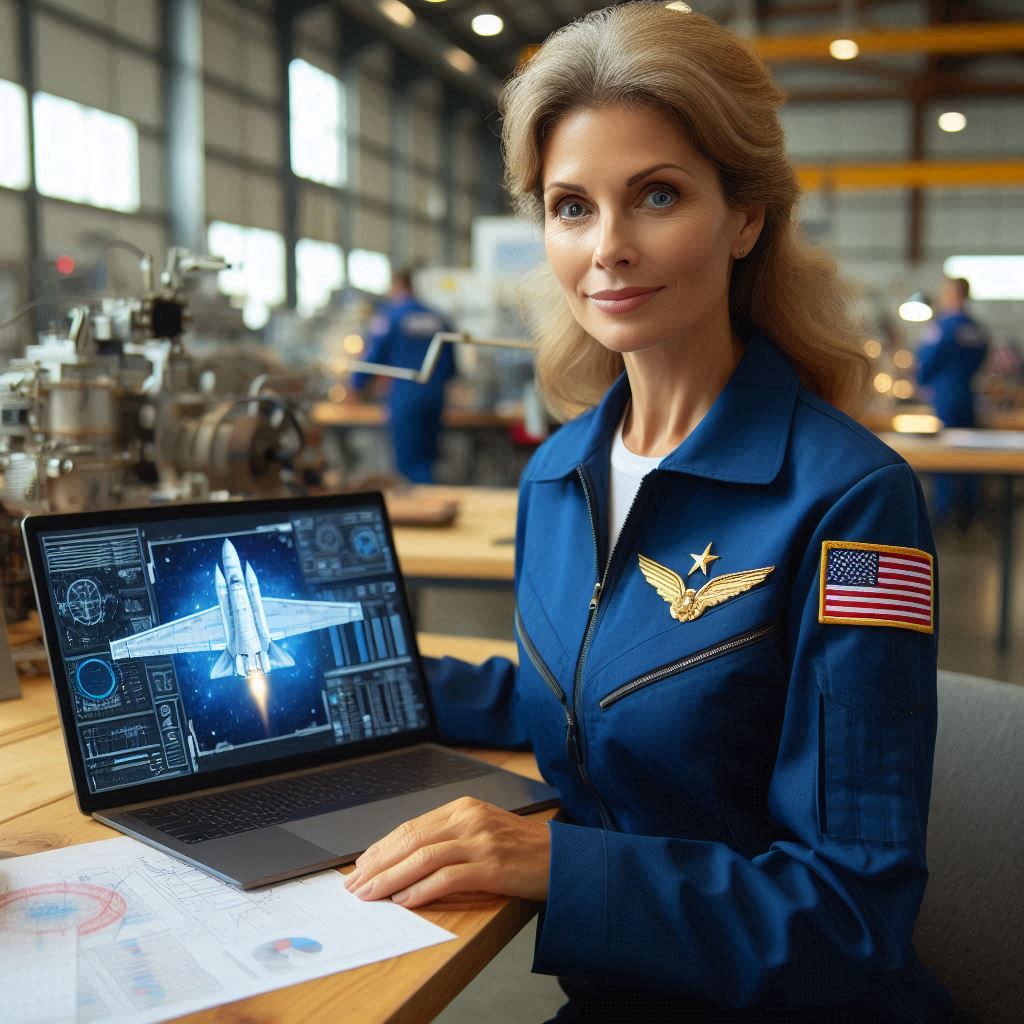Introduction
How to Stay Updated in Aerospace Engineering Field process is a multi-faceted approach crucial for developing advanced in aerospace engineering field, from aircraft to spacecraft.
This process begins with defining clear project requirements, followed by conceptual design and detailed engineering.
Engineers use sophisticated tools and simulations to model and test designs, ensuring they meet both performance and safety standards.
Understanding this design process is essential in How to stay updated in aerospace engineering field due to the complexity and high-stakes nature of the field.
Each phase conceptualization, design, testing, and iteration plays a pivotal role in creating reliable and efficient aerospace systems. How to stay updated in aerospace engineering field
Effective management of each step helps address potential issues early and optimizes overall performance.
In this blog post, we will explore the aerospace engineering design process in depth.
We will cover the importance of rigorous planning, continuous testing, and iterative refinement.
Mastering these steps is vital for How to stay updated in aerospace engineering field to develop cutting-edge technologies and contribute to advancements in the field.
Understanding this process is not only crucial for engineers but also for anyone interested in How to stay updated in aerospace engineering field.
Understanding the problem
Identifying the Need for a New Aerospace Product or Technology
The aerospace engineering design process begins with identifying the need for a new product or technology.
This need often arises from evolving market demands, technological advancements, or regulatory changes.
Engineers and stakeholders evaluate current challenges and opportunities to determine what new solutions are required.
To identify needs, aerospace engineers consider various factors, such as performance gaps, safety issues, or cost inefficiencies.
They gather input from industry experts, conduct market research, and analyze emerging trends.
This phase is crucial for ensuring that the new product addresses real-world problems and offers significant benefits.
Researching and Analyzing Existing Solutions
Once the need is identified, the next step is to research and analyze existing solutions.
This involves studying current technologies and products that address similar needs.
Engineers review literature, patents, and technical papers to understand what has already been developed and where improvements can be made.
Analyzing existing solutions helps engineers identify strengths and weaknesses in current technologies.
They assess performance metrics, design features, and user feedback to determine what works well and what does not.
This research phase is essential for avoiding duplication of effort and building on existing knowledge.
Engineers also evaluate competitors’ products to understand their market positioning and technological capabilities.
This competitive analysis provides insights into industry standards and helps in setting benchmarks for the new design.
By understanding the landscape, engineers can innovate more effectively and address unmet needs.
Defining the Problem Statement
Defining the problem statement is a critical step in the design process.
This statement clearly articulates the issue that the new product or technology aims to resolve.
It provides a focused direction for the design efforts and ensures that all team members understand the problem.
A well-defined problem statement includes specific details about the problem, including its scope and impact.
It should outline the key objectives and constraints of the project.
Engineers work closely with stakeholders to refine the problem statement, ensuring it accurately reflects the need and sets clear goals.
The problem statement serves as a foundation for the design process, guiding subsequent research, development, and testing phases.
It helps in setting priorities, allocating resources, and evaluating potential solutions.
A clear problem statement ensures that the project remains focused and aligned with its intended outcomes.
The aerospace engineering design process starts with identifying the need for a new product or technology.
Researching and analyzing existing solutions provides valuable insights and helps in building on current knowledge.
Defining a clear problem statement ensures that the project addresses specific challenges and sets a focused direction.
These initial steps are crucial for developing effective and innovative aerospace technologies that meet real-world needs and drive industry advancements.
Conceptual design
When it comes to aerospace engineering, the design process is crucial in creating successful and efficient aircraft.
The conceptual design phase is the first step in this process, where engineers brainstorm and generate ideas for potential solutions.
This stage involves evaluating and selecting the most promising concepts that meet the requirements and constraints of the project.
Engineers also develop initial sketches or models to visualize the design and test its viability.
Brainstorming and Generating Ideas for Potential Solutions
The aerospace engineering design process begins with brainstorming and generating ideas.
Teams come together to explore various solutions to the design problem.
This phase encourages creativity and open thinking, allowing engineers to propose innovative concepts.
During brainstorming sessions, all ideas are welcomed, no matter how unconventional.
This inclusive approach ensures that a wide range of potential solutions is considered.
Engineers use techniques such as mind mapping, sketching, and group discussions to capture diverse ideas.
The goal is to think broadly and explore all possible solutions before narrowing down options.
By fostering a collaborative environment, teams can leverage different perspectives and expertise to generate robust and creative solutions.
Evaluating and Selecting the Most Promising Concepts
Once ideas are generated, the next step is evaluating and selecting the most promising concepts.
Engineers assess each idea based on feasibility, effectiveness, and alignment with project goals.
Criteria such as technical viability, cost, and resource availability play a crucial role in this evaluation.
Teams use methods like feasibility studies, simulations, and prototyping to test the practicality of each concept.
A decision matrix can help compare different solutions against key criteria, ensuring a systematic approach to selection.
This evaluation process helps in identifying the most viable and innovative concepts that best meet the design requirements.
Developing Initial Sketches or Models to Visualize the Design
After selecting the best concepts, engineers develop initial sketches or models to visualize the design.
Creating visual representations helps in refining and communicating the design idea.
Initial sketches provide a basic outline of the design, highlighting key features and functionalities.
These sketches allow engineers to explore the layout and structure of the design in a tangible way.
Engineers may also create physical models or digital prototypes to better understand how the design will function.
These models help in identifying potential issues early and allow for iterative improvements.
The visualization phase is crucial for translating abstract ideas into concrete forms.
It provides a clearer understanding of the design, facilitating further development and refinement.
The aerospace engineering design process involves brainstorming, evaluating, and developing initial sketches or models.
Brainstorming fosters creativity and idea generation, while evaluation helps in selecting the most promising concepts.
Initial sketches and models visualize the design, making it easier to refine and communicate.
Each step in the process is essential for developing effective and innovative aerospace solutions.
By following these stages, engineers can systematically approach complex design challenges and create successful aerospace systems.
Read: Impact of Local Building Codes on US Architecture.
Preliminary design
Creating Detailed Design Specifications and Requirements
The aerospace engineering design process begins with creating detailed design specifications and requirements.
These specifications outline the project‘s goals, constraints, and performance criteria.
Engineers must define clear, precise requirements to ensure that the design meets its intended purpose.
Design specifications include dimensions, materials, weight limits, and operational capabilities.
Engineers must also consider safety standards and regulatory requirements.
These details help guide the development process and ensure that the final product functions correctly and efficiently.
Requirements must be realistic and achievable.
They should address all potential scenarios and use cases the aerospace system will encounter.
Detailed specifications prevent scope creep and ensure that the design process remains focused and manageable.
Conducting Feasibility Studies and Simulations
After establishing design specifications, engineers conduct feasibility studies and simulations.
These studies assess whether the proposed design can meet the requirements within the given constraints.
Feasibility studies often include cost analysis, technical assessments, and risk evaluations.
Simulations play a crucial role in testing the design under various conditions.
Engineers use computational tools and models to simulate real-world scenarios, such as aerodynamics, structural loads, and thermal stresses.
These simulations help identify potential issues and validate that the design will perform as expected.
Feasibility studies and simulations provide valuable data for decision-making.
They highlight any design flaws or limitations that need addressing before moving forward.
This step is essential for minimizing risks and ensuring that the design is viable and practical.
Refining the Design Based on Feedback and Analysis
Once feasibility studies and simulations are complete, engineers refine the design based on feedback and analysis.
They review simulation results, test data, and expert opinions to identify areas for improvement.
This iterative process involves making adjustments to enhance performance, efficiency, and safety.
Engineers incorporate feedback from various stakeholders, including project managers, clients, and regulatory bodies.
Addressing their concerns helps ensure that the design aligns with expectations and requirements.
This feedback loop is critical for achieving a final design that meets all objectives and constraints.
Refining the design often involves multiple iterations.
Engineers adjust parameters, update models, and rerun simulations to optimize the design.
Each iteration improves the design‘s performance and reliability, leading to a more robust and effective final product.
The aerospace engineering design process is a structured approach involving detailed design specifications, feasibility studies, and iterative refinement.
Creating precise design specifications ensures clear project goals and requirements.
Feasibility studies and simulations test the design‘s viability, identifying potential issues early on.
Refining the design based on feedback and analysis leads to an optimized final product.
This systematic process is essential for developing successful aerospace systems that meet performance, safety, and regulatory standards.
Read: How US Architects Adapt to Climate Change Concerns
Detailed design
Developing a Comprehensive Design that Meets All Requirements
Once the problem statement is defined, engineers develop a comprehensive design that meets all requirements.
This design must address the identified needs, comply with regulations, and fit within budget constraints.
Engineers consider factors such as functionality, safety, and performance when creating the design.
The design phase involves detailed planning and iteration.
Engineers work to ensure that the design integrates all necessary components and systems effectively.
They collaborate with stakeholders to refine the design and ensure it aligns with project goals and user requirements.
A comprehensive design includes detailed specifications for materials, dimensions, and performance criteria.
It also accounts for manufacturing processes, assembly procedures, and maintenance requirements.
By addressing all these aspects, engineers create a robust design that supports successful project outcomes.
Using CAD Software to Create 3D Models and Drawings
To bring the design to life, engineers use Computer-Aided Design (CAD) software to create 3D models and drawings.
CAD software allows engineers to visualize the design in three dimensions, providing a detailed view of its structure and components.
3D modeling in CAD software helps in identifying design flaws and making necessary adjustments before physical prototypes are built.
Engineers can test different configurations, materials, and components virtually, saving time and resources.
CAD drawings also serve as blueprints for manufacturing and assembly.
They provide precise measurements and details necessary for producing components and assembling the final product.
Accurate CAD models are essential for ensuring that all parts fit together correctly and function as intended.
Conducting Prototype Testing and Validation
Prototype testing and validation are crucial steps in the design process.
Engineers build prototypes to evaluate the design’s performance and identify any issues.
Testing involves simulating real-world conditions to ensure that the prototype meets all requirements and performs as expected.
During testing, engineers collect data on various parameters, such as structural integrity, functionality, and safety.
This data helps in assessing the design’s effectiveness and identifying areas for improvement.
Engineers make necessary modifications based on test results to enhance the prototype’s performance.
Validation ensures that the final product meets all design specifications and regulatory standards.
Engineers conduct rigorous testing to confirm that the prototype functions correctly and reliably.
Successful validation leads to the final approval of the design, paving the way for production and deployment.
The aerospace engineering design process involves developing a comprehensive design that meets all requirements.
Engineers use CAD software to create detailed 3D models and drawings, which help in visualizing and refining the design.
Prototype testing and validation are critical for ensuring that the design performs as intended and meets all specifications.
These steps are essential for creating effective and innovative aerospace technologies that achieve project goals and address real-world challenges.
Transform Your Career Today
Unlock a personalized career strategy that drives real results. Get tailored advice and a roadmap designed just for you.
Start NowRead: Diversity in the US Architectural Scene: A Deep Dive

Manufacturing and production
Choosing Materials and Production Processes
Choosing the right materials and production processes is crucial for the success of an aerospace project.
Engineers select materials based on factors such as strength, weight, durability, and resistance to environmental conditions.
The choice of materials impacts the performance and safety of the final product.
Engineers evaluate various materials, including metals, composites, and polymers, to determine their suitability for the design.
They consider material properties, cost, and availability when making their selection.
The goal is to ensure that the materials meet the design requirements and perform well under operational conditions.
Production processes also play a vital role in the design’s success.
Engineers choose processes such as machining, molding, or additive manufacturing based on the complexity and requirements of the design.
The chosen processes must ensure precision, efficiency, and scalability in manufacturing.
Collaborating with Manufacturers to Produce the Final Product
Once materials and processes are selected, engineers collaborate with manufacturers to produce the final product.
This collaboration involves detailed communication and coordination to ensure that the manufacturing aligns with the design specifications.
Engineers work closely with manufacturers to translate the design into production-ready plans.
They provide detailed drawings, specifications, and guidelines to ensure accurate fabrication.
This collaboration helps in addressing any potential manufacturing challenges and making adjustments as needed.
Effective communication with manufacturers is crucial for resolving issues, optimizing production methods, and ensuring that the final product meets all quality standards.
Engineers may also visit manufacturing facilities to oversee production and provide support during the assembly process.
Ensuring Quality Control and Adherence to Design Specifications
Ensuring quality control and adherence to design specifications is essential for delivering a reliable aerospace product.
Quality control processes involve inspecting and testing components and assemblies to verify that they meet design criteria.
Engineers develop quality assurance protocols to monitor production and ensure compliance with standards.
These protocols include inspections, testing, and validation procedures to identify and address any deviations from design specifications.
Rigorous quality control helps in detecting defects and ensuring that the final product performs as intended.
Adherence to design specifications is critical for safety and performance.
Engineers review and verify that all components and systems conform to the approved design.
This attention to detail ensures that the product meets regulatory requirements and performs reliably in its intended application.
The aerospace engineering design process includes choosing appropriate materials and production processe.
Collaborating with manufacturers, and ensuring quality control.
Selecting the right materials and processes ensures that the final product meets performance and safety requirements.
Effective collaboration with manufacturers translates the design into a finished product, while rigorous quality control ensures adherence to specifications.
These steps are essential for producing high-quality aerospace technologies that meet project goals and address real-world challenges.
Read: Freelance vs. Firm: Career Paths for US Architects
Explore Further: Essential Networking Groups for Systems Engineers
Testing and Evaluation
Conducting Rigorous Testing to Ensure the Design Meets Performance Standards
Rigorous testing is a crucial step in the aerospace engineering design process.
Engineers conduct various tests to verify that the design meets performance standards and operates as intended.
These tests simulate real-world conditions and stress the system to ensure reliability and safety.
Testing may include wind tunnel experiments, structural load tests, and thermal evaluations.
Each test assesses different aspects of the design, such as aerodynamics, material strength, and thermal management.
Engineers use these tests to validate design predictions and identify any potential issues.
Rigorous testing helps to ensure that the design performs reliably under expected operating conditions.
It also confirms that the system adheres to regulatory standards and safety requirements.
This step is essential for ensuring the final product meets all performance and safety criteria.
Analyzing Test Results and Making Necessary Adjustments
After conducting tests, engineers analyze the results to evaluate the design‘s performance.
Test data is compared against design specifications and performance standards to identify any discrepancies.
This analysis helps pinpoint areas where the design may need improvement.
Engineers look for patterns in the data that indicate potential issues, such as unexpected stresses or performance deficits.
Based on this analysis, they make necessary adjustments to the design.
These adjustments might involve modifying materials, altering dimensions, or improving system components.
The goal of this analysis is to address any performance gaps and ensure that the design meets all specified requirements.
By making informed adjustments, engineers enhance the design‘s reliability, efficiency, and safety.
Iterating on the Design to Improve Performance and Functionality
Design iteration is an ongoing process in aerospace engineering.
Engineers refine the design based on test results and analysis, making adjustments to improve performance and functionality.
This iterative approach helps to address any issues identified during testing and optimize the design.
Each iteration involves revisiting the design, implementing changes, and conducting additional tests.
This process may be repeated several times to achieve the desired performance and functionality.
Iterating on the design allows engineers to fine-tune the system and ensure it meets all performance criteria.
Continuous improvement through iteration is essential for developing high-quality aerospace systems.
It helps to ensure that the final product is robust, efficient, and capable of meeting the demands of real-world applications.
The aerospace engineering design process involves rigorous testing, analyzing test results, and iterative refinement.
Conducting thorough tests verifies that the design meets performance standards and safety requirements.
Analyzing test results allows engineers to make necessary adjustments to address any issues.
Iterating on the design ensures continuous improvement and optimization.
How to stay updated in aerospace engineering field approach is vital for developing reliable and effective aerospace systems that perform well under real-world conditions.
Uncover the Details: Environmental Technician Job Description Details
Conclusion
The aerospace engineering design process involves several key stages: defining requirements, conceptualizing solutions, detailed design, testing prototypes, and refining designs.
Each of these stages plays a crucial role in ensuring that aerospace engineering field systems are safe, efficient, and innovative.
Understanding this process helps engineers manage complex projects and address challenges systematically.
Iteration is a cornerstone of the design process.
By continuously refining and testing designs, engineers can identify and resolve issues before they escalate. How to stay updated in aerospace engineering field
This iterative approach not only improves the final product but also ensures that each design meets rigorous standards of performance and safety.
Aspiring aerospace engineers should immerse themselves in this design process.
Learning how to navigate through each phase and applying these principles will significantly impact their ability to contribute to successful projects.
Embracing continuous improvement and iterative design will enhance their skills and drive advancements in How to stay updated in aerospace engineering field.
Leading to a more successful and fulfilling career in the field.




